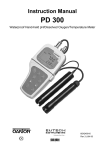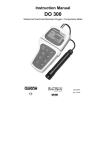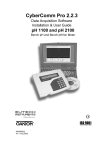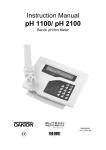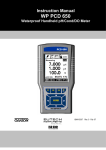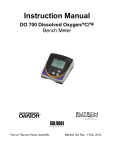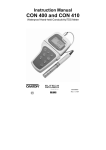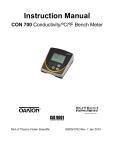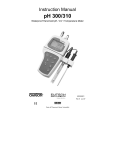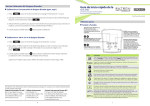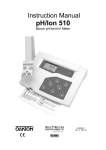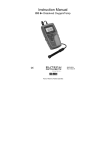Download EUTECH INSTRUMENTS CYBERCOMM PRO FOR CYBERSCAN PH 2500 Instruction manual
Transcript
Instruction Manual DO 110 Hand-held Dissolved Oxygen Meter with RS 232C 68X361305 Rev. 0 - 11/05 Technology Made Easy ... Preface This manual serves to explain the use of the hand-held series meters. The model covered is the DO 110 hand-held meter. The manual functions in two ways, firstly as a step by step guide to help the user operate the meter. Secondly, it serves as a handy reference guide. This instruction manual is written to cover as many anticipated applications of the DO meter as possible. If there are doubts in the use of the DO110 meters, do not hesitate to contact the nearest Authorised Distributor. It is recommended that all operators should read this manual prior to working with this instrument. Eutech Instruments / Oakton Instruments cannot accept any responsibility for damage or malfunction to the meter caused by improper use of the instrument. The information presented in this manual is subject to change without notice as improvements are made, and does not represent a commitment on the part of Eutech Instruments Pte Ltd / Oakton Instruments. Copyright © 2005 All rights reserved. Eutech Instruments Pte Ltd Oakton Instruments Rev. 0 - 11/05 TABLE OF CONTENTS 1 INTRODUCTION .................................................................................................... 1 2 DISPLAY & KEYPAD FUNCTIONS ...................................................................... 2 2.1 2.2 3 DISPLAY ................................................................................................................................... 2 KEYPAD ................................................................................................................................... 3 PREPARATION ..................................................................................................... 4 3.1 INSERTING THE BATTERIES ........................................................................................................ 4 3.2 CONNECTING THE DO PROBE .................................................................................................... 4 3.3 CONNECTING THE AC/DC ADAPTER ........................................................................................... 6 3.4 CONNECTING THE RS232C CABLE ............................................................................................ 6 3.4.1 RS232C Configuration..................................................................................................... 7 4 CALIBRATION ....................................................................................................... 8 4.1 IMPORTANT INFORMATION ON METER CALIBRATION ..................................................................... 8 4.2 TEMPERATURE CALIBRATION ..................................................................................................... 9 4.3 DO CALIBRATION (WITH ATC) –% SATURATION MODE .............................................................. 10 4.3.1 To calibrate 100% Saturation: ....................................................................................... 10 4.3.2 To calibrate 0% Saturation: ........................................................................................... 10 4.4 DO CALIBRATION IN MG/L (PPM) MODE..................................................................................... 11 5 MEASUREMENT ................................................................................................. 12 5.1 AUTOMATIC TEMPERATURE COMPENSATION ............................................................................. 12 5.2 MANUAL TEMPERATURE COMPENSATION (MTC) ....................................................................... 12 5.3 TAKING MEASUREMENTS ......................................................................................................... 13 5.3.1 Taking measurements with READY indicator selected on ............................................. 13 5.3.2 Taking measurements with the AUTO HOLD feature selected on ................................. 13 6 MEMORY FUNCTION.......................................................................................... 14 6.1 6.2 7 MEMORY INPUT ...................................................................................................................... 14 MEMORY RECALL ................................................................................................................... 14 PRINT FUNCTION ............................................................................................... 15 7.1 USING DO 110 METER WITH PRINTER OR COMPUTER............................................................... 15 7.2 SENDING DATA TO COMPUTER OR PRINTER ............................................................................. 16 7.2.1 Print Current Data Manually .......................................................................................... 17 7.2.2 Print Data on Timed Interval .......................................................................................... 17 7.3 PRINT DATA FROM STORED MEMORY ....................................................................................... 18 8 ADVANCED SETUP FUNCTIONS ...................................................................... 20 8.1 ADVANCED SETUP MODE OVERVIEW ...................................................................................... 21 8.2 P1.0 : UNIT CONFIGURATION (COF) ........................................................................................ 23 8.2.1 P1.1: READY Indicator and Auto Hold function ............................................................. 23 8.2.2 P1.2: Select °C or °F temperature units......................................................................... 24 8.2.3 P1.3: Selection of Automatic or Manual Temperature Compensation............................ 24 8.2.4 P1.4: Select mg/L or ppm mode .................................................................................... 25 8.3 P2.0: VIEWING PREVIOUS CALIBRATION DATA (CAL) ................................................................ 26 8.4 P3.0: VIEW ELECTRODE DATA (ELE) ....................................................................................... 26 8.4.1 EL.1 Viewing the electrode Slope Factor....................................................................... 26 8.4.2 EL.2 Viewing the % Saturation Offset (Only available in % Saturation Set Up menu): .. 27 8.4.3 Viewing the 100% Saturation mV value......................................................................... 27 8.4.4 Viewing the 0% Saturation mV value............................................................................. 27 8.5 P4.0 : AUTO-OFF (ATO).......................................................................................................... 28 8.6 P5.0 : RESET TO FACTORY DEFAULT (RST) .............................................................................. 29 8.6.1 Calibration Reset ........................................................................................................... 29 8.6.2 User Reset .................................................................................................................... 30 8.7 P 6.0: MEMORY CLEAR (CLR)................................................................................................. 31 8.8 P7.0: DISSOLVED OXYGEN PARAMETERS (DPR) ....................................................................... 32 8.8.1 Pressure Setting Adjustment ......................................................................................... 32 8.8.2 Salinity Setting Adjustment (available in mg/L or ppm Set Up mode only).................... 32 8.9 P 8.0: % SATURATION OFFSET ADJUSTMENT (OFS) ................................................................. 33 9 CYBERCOMM PORTABLE DAS ........................................................................ 34 9.1 9.2 9.3 i. ii. iii. 9.4 9.5 10 SYSTEM REQUIREMENTS ......................................................................................................... 34 LOADING CYBERCOMM PORTABLE DAS ................................................................................... 34 RUNNING CYBERCOMM PORTABLE .......................................................................................... 41 Buttons & Check-Box ........................................................................................................... 42 Menu .................................................................................................................................... 42 Communication Settings ................................................................................................... 43 CAPTURING AND PRINTING DATA INTO COMPUTER USING DATA ACQUISITION ............................. 44 TROUBLE-SHOOTING GUIDE ..................................................................................................... 44 DISSOLVED OXYGEN PROBE ....................................................................... 45 10.1 DISSOLVED OXYGEN PRINCIPLE ........................................................................................... 45 10.2 PROBE CARE ...................................................................................................................... 45 10.3 MEMBRANE HOUSING REPLACEMENT.................................................................................... 46 10.3.1 To replace the membrane cap (with pre-installed membrane) -..................................... 46 10.4 MEMBRANE/O-RING REPLACEMENT (OPTIONAL PROCEDURE)................................................. 47 10.5 ELECTROLYTE SOLUTION ..................................................................................................... 48 11 ERROR MESSAGES ........................................................................................ 49 12 TROUBLE-SHOOTING..................................................................................... 49 13 LIST OF ACCESSORIES.................................................................................. 51 13.1 REPLACEMENT METER AND METER ACCESSORIES ................................................................. 51 14 SPECIFICATIONS ............................................................................................ 52 15 WARRANTY...................................................................................................... 53 16 RETURN OF ITEMS.......................................................................................... 53 Instruction Manual 1 CyberScan DO 110 INTRODUCTION Thank you for selecting the DO 110 meter. These meters are microprocessor-based instruments and are designed to be handy, capable of allowing one-hand operation. It is capable of measuring Dissolved Oxygen (DO) in mg/L or ppm units, % saturation and temperature. This meter has many user-friendly features – all of which are completely accessible through the water-resistant membrane keypad. Please read this manual thoroughly before operating your meter. 1 Instruction Manual 2 CyberScan DO 110 DISPLAY & KEYPAD FUNCTIONS Display 2.1 The LCD has a primary and secondary display. • The primary display shows the measured % Saturation or mg/L (or ppm) values. • The secondary display shows the measured temperature. The display also shows error messages, keypad functions and program functions. Primary Display 1 2 SETUP 17 READY 16 HOLD ON 15 OFF 3 MEAS 4 CAL MEM -1.8.8.8 MEM -1.8.8.8 ERR 14 13 12 11 10 Secondary Display % 5 ppm mg/l 6 °C °F 7 8 ATC 9 Figure 1: Active LCD screen 1. SETUP - Setup mode indicator 7. mg/l- milligram per liter 2. MEAS - Measurement mode indicator 8. °C°F - Temperature indicator 3. CAL - Calibration indicator 9. ATC - Automatic Temperature Compensation indicator 4. MEM - Memory recall mode indicator 10. ERR - Error indicator 5. % - Percentage Saturation of Oxygen 11. MEM - Memory location indicator 13. 6. ppm – parts per million 12 - Low battery indicator 2 - Electrode indicator - Calibration standard 14. indicator 15. ON – READY/Auto HOLD set up enable indicator. OFF – READY set up disable indicator 16. HOLD – Hold indicator 17. READY – Ready indicator Instruction Manual 2.2 CyberScan DO 110 Keypad A large membrane keypad makes the instrument easy to use. Some buttons have several functions depending on its mode of operation. KEY ON OFF CAL MEAS FUNCTION • ON/OFF - Powers on and shuts off the meter. The meter will start in a measurement mode similar to the last measurement mode it is in before being switched off. • CAL - Activates the DO % Saturation or mg/l calibration mode and when used with the MODE key, it activates the temperature calibration mode. • MEAS - Allows return to measurement mode when canceling or terminating any operation. • HOLD - Activates/Deactivates freezing of the measured reading while in measurement mode. HOLD ENTER • ENTER - Confirms the calibration values in Calibration mode and the selection in SETUP and Print Function mode. Scroll through the memory location and the stored data during memory recall. MI • MI (Memory Input) - Captures the measured readings with its corresponding temperature values and stores them in the memory. • MR (Memory Recall) - Retrieves the stored data from memory. MR • ▲▼ - Sets the calibration values during mg/l or temperature calibration. Scrolls through each SETUP and its sub group menu. Scroll through Print Function menu and its parameters. SETUP MODE • SETUP - Activates the parameter setting menu to allow you to customise meter configuration, view calibration point and electrode data, select auto power off, reset meter, clear memory, set % Saturation Offset and set dissolved oxygen parameters. . • MODE - Selects the measurement parameter option between % Saturation with temperature and mg/L (or ppm) with temperature. • PRINT - Allows print of current measurement or stored data to either the printer or the computer. 3 Instruction Manual 3 3.1 CyberScan DO 110 PREPARATION Inserting the Batteries This meter is packaged with 4 “AAA” alkaline batteries required for operation. To insert the batteries into the meter, follow the procedure outlined below. 1. To open the battery compartment, press down the catch of the battery cover. See below. 2. Note the polarity and insert the batteries into the battery compartment correctly 3. Replace the battery cover into its original position, ensuring the catch is locked in position. Your hand-held meter is now ready for operation. LR03 'AAA' (AM4) MADE IN S'PORE Figure 3: Note battery's polarity Figure 2: Open Battery Cover 3.2 Connecting the DO Probe The DO 110 uses a special notched 6-pin connector to attach the probe to the meter. 4 Instruction Manual CyberScan DO 110 NOTE: Do not substitute other probes or electrodes. For replacement probe, see the “Accessories” section. Keep connector dry and clean. Do not touch connector with soiled hands. 1. Line up the notch and 6 pins on the meter with the holes in the 6 pin connector. Push down and screw the metal sleeve to lock the probe connector into place. 2. To remove probe, unscrew the metal sleeve and slide up the probe connector. While holding onto metal sleeve, pull probe away from the meter. CAUTION: Do not pull on the probe cord or the probe wires might disconnect. 5 Instruction Manual 3.3 CyberScan DO 110 Connecting the AC/DC Adapter Besides using four AAA-sized batteries as a power source, the DO 110 meter can also operate from the power mains using an AC/DC power adapter. This is extremely useful if you have an A.C. power source available (e.g. laboratory). Before plugging in, switch off the meter and the power source of adapter. This is a safety precaution that should be adhered to safeguard your meter. 1. Switch off the meter and power sources. 2. Select the correct AC/DC Adapter which matches your input mains voltage. 3. Select the correct output voltage of the AC/DC adapter. (Output Voltage: 9 to 15 V DC, Current: >=50 mA). 4. Gently insert the power adapter D.C. jack into the meter power socket. 5. Switch on the power source of the adapter followed by the meter. 3.4 Connecting the RS232C Cable The DO 110 meter provides a RS232C output for you to transmit your readings either to a printer or a computer via a cable. This is useful in instances where the meter is used for continuous monitoring of a certain process or experiment. Data output to the printer or the computer can then be evaluated. The data is output in the ASCII format. This format allows the data to be imported by a wide variety of software that read ASCII data (e.g. Microsoft’s Excel, Lotus, Quattro-pro etc.). A complimentary Data Acquisition Software (DAS) is provided and it captures data transmitted into an ASCII file for later use. Figure 4: Location of RS232C 1. Open the printer port cover located at the bottom end of the meter. Do not use excessive force when doing this. See Figure 4. 2. Noting the orientation of the RS232C connector, plug the male connector into the RS232C port of the meter. 3. Fasten the RS232C connector by fastening the two screws at the side of the male RS232C connector. 6 Instruction Manual 3.4.1 CyberScan DO 110 RS232C Configuration The DO 110 meter has a 9 pin female RS232C connector with the following pin out: PIN NO. DESCRIPTION 1 - 2 Transmit Data 3 - 4 - 5 CTS (Clear to Send) 6 - 7 GND (Ground) 8 - 9 - A one-to-one connection can be made with a 9 pin RS232C port of the computer. 5 4 9 3 8 1 2 7 6 In case DO 110 meter’s output has to be sent to a 25 pin RS232C connector, the following cable configuration may be used: DO 110 25 pin connector 2 (TxD) (RxD) 3 5 (CTS) (RTS) 4 7 (GND) (GND) 7 7 Instruction Manual 4 4.1 CyberScan DO 110 CALIBRATION Important Information on Meter Calibration The amount of oxygen dissolved in water will depend on its temperature, atmospheric pressure and its salinity. While the pressure and salinity values are manually entered into the instrument, the temperature is being measured by the probe. It is therefore very important that the temperature is calibrated if necessary prior to the DO calibration. The measurements of % Saturation of DO will linearly affect the measurement for DO in mg/L. Hence calibration in % Saturation of DO should be carried out first. This is described in the following section. Before calibrating, press MODE key to select the correct measurement mode. There are 2 measurement modes for DO: mg/L or ppm, and % Saturation. NOTE: All new calibrations will automatically over-ride existing calibration values. 8 Instruction Manual 4.2 CyberScan DO 110 Temperature Calibration DO in mg/L is dependent on temperature, so it is first necessary to calibrate or verify the temperature reading. The temperature sensor is part of the DO probe and the “ATC” annunciator will light up on the LCD screen once the probe is connected correctly to the meter. MEAS 98.9 22.3 83.4 MODE CAL 22.3 4. Dip the DO probe into a solution of known temperature (i.e. a temperature bath). Allow time for the temperature probe to stabilise. 22.3 MR 5. Scroll with the MI/▲ or MR/▼ keys to set the correct temperature value (i.e. the temperature of the temperature bath). You can adjust the reading in increments of 0.1°C. 9 °C ATC MI CAL 22.0 22.3 6. Once you have selected the correct temperature, press the HOLD/ENTER key. The meter automatically returns to the measurement mode. It displays the value being measured currently, offset by the last calibration. % 100.0 3. While in calibration mode, press the MODE key to enter temperature calibration mode. The primary display shows the measured temperature reading according to the last set offset1 and the secondary display shows the factory calibrated temperature measurement. 1 ATC CAL 2. Press the CAL/MEAS key to enter calibration mode. To exit this program without confirming the temperature calibration value, DO NOT press ENTER. Press CAL/MEAS instead. °C CAL MEAS 1. Switch the meter on. The ATC annunciator will appear at the right-hand side of the LCD. NOTES: You can offset the temperature reading up to ±5°C from original reading. % °C ATC HOLD ENTER MEAS READY 98.9 22.0 % °C ATC Instruction Manual 4.3 CyberScan DO 110 DO Calibration (with ATC) –% Saturation Mode Dissolved Oxygen exact calibration value depends on barometric pressure. The meter is set to a factory default of 760 mm Hg, which results in a calibration value of 100% saturation in air. NOTE: If the barometric pressure setting has been changed from 760 mm Hg, the calibration value in air will automatically adjust to a value other than 100%. The adjusted value will be correct for the new barometric pressure setting. See Section 8.8.1 for barometric pressure setting. 4.3.1 MEAS % 83.4 READY °C 25.3 ATC CAL MEAS To calibrate 100% Saturation: CAL 1. Press MODE key to select % Saturation mode. READY 2. Rinse the probe well with deionised rinse water. For best accuracy, blot the end of the probe dry. Do not touch the membrane. 3. Hold the probe in the air gently with the sensor facing down and press CAL key to calibrate the meter. The primary display will show the current value of measurement and the secondary display will show “100.0” (or the value corrected to its barometric pressure setting) to which the meter is going to be calibrated. Wait for the reading to stabilize. % 83.4 100.0 HOLD ENTER MEAS % 100.0 READY 25.3 °C ATC 4. Press ENTER key to confirm the calibration. The meter automatically calibrates to 100% air saturation and returns to the measurement mode. MEAS 4.3.2 3.4 READY To calibrate 0% Saturation: 25.3 1. Press MODE key to select % Saturation mode 2. Rinse the probe well with deionised rinse water. 3. Immerse the DO probe in 0% solution. Stir gently to create a homogenous solution. Wait for the reading to stabilize. ATC CAL READY 3.4 % 0.0 HOLD ENTER MEAS READY NOTE: To exit from DO Calibration mode without confirming calibration, DO NOT press ENTER. Press CAL/MEAS instead 10 °C CAL MEAS 4. Press CAL key to calibrate the meter. The primary display will show the current value of measurement and the secondary display will show “0.0” to which the meter is going to be calibrated. 5. Press ENTER key to confirm the calibration. The meter automatically calibrates to 0% saturation and returns to the measurement mode. % % 0.0 25.3 °C ATC Instruction Manual 4.4 CyberScan DO 110 DO Calibration in mg/L (ppm) Mode The amount of oxygen dissolved in a liquid will depend on its temperature, pressure and salinity. It is therefore very important to set these parameters correctly before attempting to do a calibration. Temperature is measured by the meter automatically. Pressure and salinity values are keyed in manually as described in Sections 8.8.1 and 8.8.2. MEAS READY 8.10 24.5 CAL READY 8.10 8.10 MR 8.24 8.10 mg/l °C ATC HOLD ENTER 5. Adjust to the required value by pressing MI/S or MR/T key. MEAS READY 11 ATC MI 4. Wait until the reading stabilizes. Press CAL key. NOTE: To exit from DO Calibration mode without confirming calibration, press CAL/MEAS key. mg/l °C CAL READY 3. Dip the probe into a solution whose DO value is known. 6. Press ENTER to confirm the calibration. ATC CAL MEAS 1. From the measurement mode, press MODE key to select mg/L (ppm). 2. Rinse the probe well with deionised rinse water. For best accuracy, blot the end of the probe dry. Do not touch the membrane. mg/l °C 8.24 24.5 mg/l °C ATC Instruction Manual 5 CyberScan DO 110 MEASUREMENT During measurement, care must be taken not to allow the membrane of the DO probe touch any surface. The probe can either be fully or partially immersed in the solution. The READY indicator appears on the display when the readings stabilize. It will turn off if the readings start to fluctuate. NOTE: It is important that the sample is stirred constantly to allow it to flow past the membrane for better readings. 5.1 The ATC indicator on the LCD temperature compensation (ATC). 5.2 MEAS Automatic Temperature Compensation indicates 98.9 automatic Manual Temperature Compensation (MTC) 24.5 °C ATC Figure 5: ATC indicator For manual temperature compensation (MTC), you must set the ATC mode in the SETUP menu Program P 1.3 to “NO”. See section 8.2.3. The [ATC] annunciator will disappear from the LCD indicating manual temperature compensation mode. CAL 25.0 25.0 1. Press the CAL/MEAS key to enter DO calibration mode. MR 2. While in DO calibration mode, press the MODE key to enter temperature calibration mode. The primary display act as the adjustable temperature setting and the secondary display shows the default temperature value of 25°C or indicates the last set temperature setting. 3. Check the temperature of your sample using an accurate thermometer. % °C MI CAL 30.0 25.0 °C HOLD ENTER MEAS READY % 98.9 4. Press the MI/▲ or MR/▼ keys to set the temperature to the measured value from step 3. 30.0 °C 5. Press HOLD/ENTER key to confirm the selected temperature and to return to the measurement mode. 6. The meter will now compensate DO readings for the manually set temperature. NOTES: To exit this program without confirming the manual temperature compensation value, DO NOT press ENTER in step 5. Press CAL/MEAS instead. 12 Instruction Manual 5.3 CyberScan DO 110 Taking Measurements 1. Rinse the probe with deionised or distilled water before use to remove any impurities adhering to the probe body. If it is dehydrated, soak it for 30 minutes in tap water. 2. Switch on the meter. The MEAS annunciator appears on the top of the LCD. The ATC indicator appears in the lower right hand corner to indicate Automatic Temperature Compensation. 3. Dip the probe into the sample and allow some time for the reading to stabilize NOTE: When dipping the probe into the sample, make sure the tip of the probe is completely immersed. Stir the sample gently to create a homogenous sample. Be sure to tap probe very gently to remove air bubbles. Air bubbles will cause errors in the reading. 4. .When the reading is stable, the READY annunciator appears. Note the reading on the display. 5. Press the HOLD key to freeze the value of the DO reading for a delayed observation. Press the HOLD key again to release the held values. MEAS 98.9 24.5 6. To toggle between % Saturation and mg/l (ppm) measurement mode, press the MODE key. NOTE: This meter shuts off automatically after 20 minutes of last key press. If the meter is shut off either automatically or manually, the HOLD value will be lost. For longer storage, use the memory functions. 5.3.1 % °C ATC MODE MEAS READY 8.24 24.5 mg/l °C ATC Taking measurements with READY indicator selected on If the READY indicator has been activated, the READY annunciator lights when the reading is stable. You can switch the READY indicator on or off in SETUP program. See 8.2.1 - P1.1: READY Indicator and Auto Hold function on page 23. 5.3.2 Taking measurements with the AUTO HOLD feature selected on When a reading is stable for more than 5 seconds, the AUTO HOLD feature will automatically “HOLD” the reading. The “HOLD” indicator appears on the left side of the display. Press the HOLD/ENTER key to release the reading. Switch the Auto Hold feature on or off in SETUP program in section 8.2.1 - P1.1: READY Indicator and Auto Hold function on page 23. 13 Instruction Manual 6 CyberScan DO 110 MEMORY FUNCTION The DO 110 meter can store up to 100 sets of data. You can store data in any combination of values such as “% Saturation and temperature” or “mg/L (or ppm) and temperature”. 6.1 MEAS Memory Input 98.9 1. During any measurement function (MEAS), press MI/▲ key to input any data into the memory. 24.5 % °C ATC MI 2. MEM, “Sto” and memory number will flash. The meter then returns to measurement mode. MEM 3. If the memory is full, the display will flash “MEM – FUL” momentarily (Figure 7). The first value stored will be erased to create space for the new value. MEM 1 Figure 6: Data storage in memory MEM FUL MEM Figure 7: Memory full 6.2 Memory Recall This function recalls the previous readings stored in the memory. Memory recall is in “Last In First Out” order. To recall readings: 1. Press the MR/▼ key once to retrieve the last reading stored. The memory location screen – MEM, “Loc” and the memory number – will flash on the display. MEM 2. Press the HOLD/ENTER key to recall the reading stored under that memory number. 3. To display next stored reading, press HOLD/ENTER key. The display automatically moves to the next lower memory location screen. loc 26 MR MI MEM loc 4. To view a stored reading in a specific memory location, press MI/▲ or MR/▼ keys to locate it, and press 25 HOLD/ENTER key to display the reading. Figure 8: Scroll up or down for specific memory location NOTE: Readings stored in memory are retained even if the unit is turned off. To erase all readings stored in memory, use the SETUP in section 8.7 – P 6.0: Memory Clear (CLr) on page 31. 14 Instruction Manual 7 CyberScan DO 110 PRINT FUNCTION The DO 110 meter is equipped with an RS232 communication port and a PRINT ( ) key that facilitate the printing of data from the meter to a printer or computer. 7.1 Using DO 110 Meter With Printer or Computer 1. To use the DO 110 directly with a printer, the printer should have either a 9 pin or a 25 pin RS 232C serial port. 2. Communication settings of the printer or computer’s data acquisition software (CyberComm Portable DAS) MUST match the following parameters: a. Baud Rate: 9600 b. Parity Bit: None c. Stop Bit: One d. Data Bit: 8 e. Flow Control: None 3. Please refer to your printer’s or computer’s instruction manual for more information on its communication setup protocol. 4. Use 9-pin cable (Refer to section 13 - LIST OF ACCESSORIES on page 51) to connect the meter to the printer. If the printer has a 25 pin connector, use the 9 to 25 pin cable or make your own cable taking note of the connection parameters as described in section 3.4.1 - RS232C Configuration on page 7. 5. Turn on DO 110 meter and note the following: a. For printer, ensure it is powered on and paper is loaded. b. For computer, ensure that Eutech Instruments’ CyberComm Portable Data Acquisition Software is installed and activated. See section 9.3 - on page 41. 6. To send data to the printer or computer, press the PRINT key. 15 Instruction Manual CyberScan DO 110 Sending Data To Computer or Printer 7.2 When the PRINT key is pressed, there are two options: • dAt / CUr: Print Data on Timed Interval basis. You can print any data automatically based a pre-set timing from 5 to 30 seconds. • dAt / StO: Print Stored Data from Memory. This simply dumps all data stored in memory. You cannot print data from selected memory locations. See Figure below. From measurement mode. HOLD ENTER MR MI HOLD ENTER Figure 9: Print data based on timed interval or from memory 16 Instruction Manual 7.2.1 CyberScan DO 110 Print Current Data Manually MEAS To manually print any data that is currently being measured: READY 8.10 HOLD 24.5 1. From measurement mode, press HOLD key to freeze reading. See Figure 10. 2. Print PRINT ( mg/l °C ATC ) key. 3. The “Prn – CUr” annunciator will appear and flash for about 0.5 seconds. The data is transmitted to the printer or computer. Flash for 0.5 seconds 4. The meter returns to measurement mode. 5. Repeat steps 1 to 3 for next measurement. MEAS READY 8.10 24.5 7.2.2 Print Data on Timed Interval mg/l °C ATC Figure 10: Print current data manually This feature is useful to automate printing and downloading ‘live’ measurement values into computer. The time interval setting can range from 5 to 30 seconds. 1. From the measurement mode, press PRINT key. 2. Select “Dat/Cur” screen and press HOLD/ENTER key. 3. The “Sec 5” screen appears. The default value is 5 seconds time interval. HOLD ENTER 4. Press MI/▲ or MR/▼ key to set a value suitable for your application. sec 5 5. Press HOLD/ENTER key. MR 6. The meter goes into measurement mode with MEM annunciator flashing. MI sec 7. At a pre-set time interval, the screen flashes “Prn/CUr” momentarily (printing data) and switches back to measurement mode with MEM annunciator flashing. 10 Figure 11: Print data on timed interval 8. To stop printing, press PRINT key. The MEM annunciator disappears and the meter is on measurement mode. 17 Instruction Manual 7.3 CyberScan DO 110 Print Data from Stored Memory The DO 110 meter can print data that is stored in the memory. You can print out all stored data or selected data based on its memory location. To Print All Stored Data 1. From measurement mode, press PRINT key. 2. Use MI/▲ or MR/▼ key, select “dAt – StO” option and press HOLD/ENTER key. See Figure 9. 3. At the “SEC – 0” option, use MI/▲ or MR/▼ key to select number of seconds to print each set of stored data. This setting gives flexibility to match the meter to a printer’s or computer’s ability (or buffer size) to accept data and prevent overflow. 4. Press HOLD/ENTER key. The “Prn” primary display will flash until all data is printed. 5. To stop printing, press PRINT key and exit to measurement mode. See Figure 12. NOTE: All stored memory will remain in the meter after printing. From measurement mode MEAS READY 8.10 24.5 mg/l °C ATC HOLD ENTER sec 0 MR Flash until all stored data are downloaded. Press PRINT key to exit to measurement mode MI sec 10 HOLD ENTER Set timed interval to download stored data to printer or computer Figure 12: Print all stored data 18 Instruction Manual CyberScan DO 110 To Print Selected Stored Data: 1. From measurement mode, press MR/▼ key. 2. “MEM” indicator appears and the last memory input location is displayed. 3. Press MI/▲ or MR/▼ key to select a specific memory location, and press HOLD/ENTER key. 4. When ready, press PRINT key. 5. The screen flashes “Prn/CUr” for about 0.5 seconds and switches back to the stored data of the specific memory location. 6. Press HOLD/ENTER key. The meter is now ready to recall the next stored data in the following memory location. See Figure 13. During measurement mode MEAS 8.10 READY 24.5 Repeat print procedure or press CAL to exit mg/l °C ATC MR MEM MEM loc loc 9 20 Last memory input location MR Moves to next memory location HOLD ENTER MI MEM MEM loc 5.69 10 HOLD ENTER 22.4 mg/l °C ATC For example,select memory location 10 Flash for 0.5 seconds MEM 5.69 22.4 mg/l °C ATC Figure 13: Print based on selected stored data from memory For more information about Eutech Instruments’ CyberComm Portable Data Acquisition Software programme, see section 9 - CYBERCOMM PORTABLE DAS on page 34. 19 Instruction Manual 8 CyberScan DO 110 ADVANCED SETUP FUNCTIONS The advanced setup mode lets you customize your meter to suit your preference. The DO 110 meters feature different sub groups that organize all setup parameters. The sub-groups are: For %Saturation For mg/L P1.0 Unit Configuration P1.0 Unit Configuration P2.0 Calibration Points P2.0 Calibration Points P3.0 Electrode Status P3.0 Electrode Status P4.0 Auto Power Mode P4.0 Auto Power Mode P5.0 Reset P5.0 Reset P6.0 Memory Clear P6.0 Memory Clear P7.0 % Saturation Offset Adjustment P7.0 % Saturation Offset Adjustment P8.0 Dissolved Oxygen Parameters P8.0 Dissolved Oxygen Parameters with Salinity Setup 20 Instruction Manual 8.1 CyberScan DO 110 Advanced SETUP Mode Overview Press the SETUP key to enter Setup mode. Press the MI/▲ and MR/▼ keys to scroll through the sub groups. P1.0: Unit Configuration SETUP COF P 1.0 P1.1 Ready indicator (On, Off or Auto Hold) P1.2 Select °C or °F temperature units P1.3 Select Automatic Temperature Compensation (ATC) P1.4 Select mg/L or ppm mode (from mg/L or ppm mode only) P2.0: View Previous pH Calibration Data (View only) SETUP CAL pH P2.1 % Saturation calibration point ( from % Saturation setup) or mg/L(ppm) calibration point (from mg/L or ppm setup only) P 2.0 P3.0: View Electrode Data (View only) In % Saturation mode: EL.1 SETUP ELE P 3.0 Electrode Slope Factor EL.2 % Saturation Offset EL.3 100% Saturation mV value EL.4 0% Saturation mV value In mg/L (or ppm) mode: EL.1 Electrode Slope Factor EL.2 100% Saturation mV value EL.3 0% Saturation mV value P4.0: Select Auto Power On/Off SETUP A0 P4.0 Select auto power on or off P 4.0 P5.0: Reset to Factory Default SETUP P5.1 Reset calibrated data P5.2 User reset back to factory default values P 5.0 SETUP MEM P6.0: Memory Clear P6.0 Clear all stored readings P 6.0 21 Instruction Manual CyberScan DO 110 P7.0: Dissolved Oxygen Parameter SETUP P7.0 Select Barometric Pressure unit Set Barometric Pressure value Set Salinity value (from mg/L or ppm mode only) p 7.0 P8.0: % Saturation Offset Adjustment SETUP OFS (only in % Saturation Set up mode) P8.0 Set offset adjustment p 8.0 22 Instruction Manual CyberScan DO 110 P1.0 : Unit Configuration (COF) 8.2 This subgroup program allows customising the meter to your specific needs. In Program 1.0, features like the ‘READY’ Indicator, Auto Hold function, °C or °F mode selection, ATC or MTC mode selection and DO mg/L or ppm mode selection are available for customization. 8.2.1 P1.1: READY Indicator and Auto Hold function Program P1.1 lets you select “READY indicator on” to indicate when the reading is stable, or select “READY indicator off” for faster meter response. In the DO 110 meter, program P1.1 also lets you switch the auto hold function on or off. Select auto hold on to “HOLD” the reading when it is stable for more than 5 seconds. The display automatically freezes, and the HOLD indicator appears on the left side of the display. Press the HOLD/ENTER key to release the display and access other functions. Select auto endpoint off to deactivate this feature. From measurement mode SETUP 1. Press SETUP key to enter Set Up mode. 2. At COF – P1.0 parameter, press HOLD/ENTER key to select parameter P1.1. 3. Press the MI/▲ or MR/▼ keys to select the configuration you require. READY ON • OFF switches the READY indicatory off. • ON switches the READY indicator on. • ON and HOLD together switches the auto hold feature on. p 1.1 MR SETUP READY OFF p 1.1 MR 4. Press the HOLD/ENTER key to confirm selection and to proceed to step 2 of P1.2. Press the CAL/MEAS key to return to measurement mode. MI MI SETUP READY HOLD ON p 1.1 Figure 14: P1.1 - Configure READY ON, OFF or HOLD NOTE: Meter default is set for READY indicator on and auto hold function off. 23 Instruction Manual 8.2.2 CyberScan DO 110 P1.2: Select °C or °F temperature units The DO 110 meter lets you select between °C and °F units for temperature readings. SETUP C From measurement mode p 1.2 1. Press SETUP key to enter Set Up mode. 2. Press the MI/▲ or MR/▼ keys to scroll through subgroups until you view parameter P1.0. 3. Press the HOLD/ENTER key two times to select parameter 1.2. 4. Press the MI/▲ or MR/▼ keys to toggle between °C and °F. 5. Press the HOLD/ENTER key to confirm selection and to return to the subgroup menu. Press the CAL/MEAS key to return to measurement mode. 8.2.3 MR MI SETUP f p 1.2 °F Figure 15: P1.2 - Select temperature units, °C or °F P1.3: Selection of Automatic or Manual Temperature Compensation This feature lets you select between Automatic Temperature Compensation (ATC) and Manual Temperature Compensation (MTC). Meter default is ATC. SETUP From measurement mode 1 °C P 1.3 °C YES °C ATC Press SETUP key to enter Set Up menu. HOLD 2 3 4 Press the HOLD/ENTER keys until you view parameter P1.3. ENTER SETUP Press the HOLD/ENTER key again. The upper display shows “ATC” and the lower display shows “YES” or “NO”. Press MI/▲ or MR/▼ keys to select between Automatic and Manual Temperature Compensation. • “YES” activates the Automatic Temperature Compensation function. • “NO” activates the Manual Temperature Compensation function. 5 Press the HOLD/ENTER key to confirm selection and to return to the subgroup menu. 6 Press the CAL/MEAS key to 24 return to MI ATC MR SETUP °C Figure 16: P1.3-Select Automatic or Manual Temperature Compensation Instruction Manual CyberScan DO 110 measurement mode. 8.2.4 P1.4: Select mg/L or ppm mode SETUP (Only in mg/L (ppm) Set Up mode) mg/l From the mg/L (ppm) Set Up mode, p 1.4 1. Press the HOLD/ENTER key four times to enter the mg/L or (ppm) mode selection menu “dO”. 2. Use the ▲ and ▼ keys to select the desired mode of measurement. 3. Press the HOLD/ENTER key to confirm the selection made and to return to the subgroup menu. MR MI SETUP ppm p 1.4 4. Press the CAL key to return to the measurement mode. Figure 17: P1.4- Select mg/L or ppm mode 25 Instruction Manual 8.3 CyberScan DO 110 P2.0: Viewing Previous Calibration Data (CAL) This mode lets you recall previous calibration data, which helps you know when to re-calibrate your meter. This is a “view only” mode. SETUP cal p 2.0 From measurement mode: 1. Press the SETUP key to enter Set up mode. HOLD ENTER 2. Press the MI/▲ or MR/▼ keys to scroll through subgroups until you view parameter P2.0. SETUP 3. Press the HOLD/ENTER key to view previous calibration data. CAL 100.0 % p 2.1 4. Press the HOLD/ENTER key to return to subgroup menu. Figure 18: P2.0 - View previous calibration data 8.4 P3.0: View Electrode Data (ELE) This menu features data of the electrode properties for diagnostic purposes. The “view only” parameters such as the electrode Slope Factor (k), % Saturation Offset setting, 100% Saturation mV value and 0% Saturation mV value are very useful in determining the life efficiency of the electrode. These electrode properties can be examined through its data in % Saturation and mg/L (ppm) which is available in their Set Up menu respectively. 8.4.1 EL.1 Viewing the electrode Slope Factor SETUP This parameter lets you view and gives an indication of the probe’s efficiency. The value displayed is the ratio of the theoretical value and the actual value produced by the probe. The higher the number, the lower the mV output from the probe. The ratio displays from 0.5 to 1.999. ele p 3.0 HOLD ENTER From the % Saturation menu, SETUP 1. Press the SETUP key to enter Set up mode. 1.231 K= 2. Press the MI/▲ or MR/▼ keys to scroll through subgroups until you view parameter P3.0. 3. Press the HOLD/ENTER key to enter the menu and view the Slope Factor (K) of the electrode. 26 EL.1 Figure 19: P3.0 - View Electrode Slope Factor Instruction Manual 8.4.2 CyberScan DO 110 EL.2 Viewing the % Saturation Offset (Only available in % Saturation Set Up menu): This parameter shows you the amount of the % Saturation Offset entered in the other parameter “OFS” P7.0. From Step 3 above, HOLD ENTER 4. Press the HOLD/ENTER key to enter the % Saturation Offset viewing menu. The meter will display the last offset adjustment made. 8.4.3 SETUP % 10.0 EL.2 Viewing the 100% Saturation mV value This parameter shows the sensor’s corresponding to 100% Saturation. mV output From Step 4 above, HOLD ENTER SETUP mV 5. Press the HOLD/ENTER key. The display will show the sensor’s mV output value with respect to 100% Saturation. 8.4.4 30.0 EL.3 Viewing the 0% Saturation mV value This parameter lets you view the sensor’s mV output corresponding to 0% Saturation. From Step 5 above, 6. Press the HOLD/ENTER key. The display will show the sensor’s mV output value with respect to 0% Saturation. 7. Press the HOLD/ENTER key again to exit to the subgroup menu. Press CAL to return to the measurement mode. HOLD ENTER SETUP mV 0.3 EL.4 Figure 20: P3.0 - View % Saturation offset, electrode mV value in 100% and 0% saturation Note: To view the electrode properties in the mg/L (ppm), repeat the whole steps above using the mg/L (ppm) Set Up menu. Viewing of the % Saturation Offset will be skipped in this menu and the viewing sequence will as follows: EL.1 Electrode Slope Factor EL.2 100% Saturation mV value EL.3 0% Saturation mV value 27 Instruction Manual 8.5 CyberScan DO 110 P4.0 : Auto-Off (AtO) In Program P4.0 you can activate the AUTO-OFF option to automatically power off the instrument 20 minutes after the last key selection. This feature is useful for conserving battery power. Under default conditions, the instrument has this option activated. SETUP 1. Press the SETUP key to enter Set Up mode. 2. Press the MI/▲ or MR/▼ keys to scroll through subgroups until you view parameter P4.0. P4.0 3. Press the HOLD/ENTER key. HOLD ENTER 4. Press MI/▲ or MR/▼ keys to select options SETUP 5. ‘YES” - Meter will automatically switch off 20 minutes after the last key operation. yes 6. ‘NO’ - Auto Off mode is switched off. 7. Press the HOLD/ENTER key to confirm and return to P4.0. 8. At any point, you can press the CAL/MEAS key to return to measurement mode. MR MI SETUP Figure 21: P4.0 - Auto shut off feature 28 Instruction Manual 8.6 CyberScan DO 110 P5.0 : Reset to Factory Default (rSt) This mode lets you reset all parameters to factory default settings. There are two levels of reset: • Calibration Reset: Reset only the calibration values of % Saturation and mg/L (or ppm). This clears all previous calibrated values and reset to factory default. SETUP P5.0 • User Reset: Clears all data including calibration, memory and other customised setup functions and reset it to factory default. HOLD ENTER SETUP 8.6.1 CAL Calibration Reset From measurement mode: P5.1 1. Press SETUP key to enter Set Up mode. 2. Press the MI/▲ or MR/▼ keys to scroll through subgroups until you view parameter P5.0. 3. Press the HOLD/ENTER key. HOLD ENTER SETUP CAL 4. Press the MI/▲ or MR/▼ keys to toggle between NO and YES. • ‘NO’ retains current settings • ‘YES’ erase calibration settings. 5. Press the selection. HOLD/ENTER key to MR MI confirm SETUP • If ‘NO’ is selected, it will retains current settings and proceed to next program P5.2 – User Reset. • If ‘YES’ is selected, all LCD segments will lit up for one second, erase calibration values, and the meter switches to the measurement mode. 6. Otherwise press CAL/MEAS key to return to measurement mode without resetting to factory default. 29 CAL yes Select either "YES" or "nO", press ENTER key to confirm. Figure 22: P5.1 - Calibration reset Instruction Manual 8.6.2 CyberScan DO 110 User Reset This program clears all data including calibration, memory and other customised setup functions and reset it to factory default. SETUP You can skip program P5.1 (Calibration Reset) and proceed straight to Program P5.2: P5.2 1. From Program P5.0 - rSt, press HOLD/ENTER key three times to P5.2. Press HOLD/ENTER key again to enter the User Reset menu. 2. Press the MI/▲ or MR/▼ keys to select or deselect the user reset function. HOLD ENTER SETUP • ‘NO’ retains current settings • ‘YES’ resets to factory default settings. MR 3. Press the ENTER key to confirm selection. 4. If ‘NO’ is selected, it will retains current settings and goes back to program 5.0. 5. If ‘YES’ is selected, all LCD segments will light up for one second, reset to factory default settings, and the meter will be in the measurement mode. 6. Otherwise press CAL/MEAS key to return to measurement mode without resetting to factory default. MI SETUP yes Select either "YES" or "nO", press ENTER key to confirm. Figure 23: P5.2 - User reset 30 Instruction Manual 8.7 CyberScan DO 110 P 6.0: Memory Clear (CLr) Use this parameter to clear all memory values when you need to store a new series of values. This lets you avoid confusing the old values with the new ones. NO is the default setting. SETUP MEM NOTE: Selecting YES will wipe out all memory. From measurement mode: p 6.0 1. Press the SETUP key to enter Set Up mode. 2. Press the MI/▲ or MR/▼ keys to scroll through subgroups until you view the parameter P6.0. 3. Press the HOLD/ENTER key. HOLD ENTER SETUP MEM 4. Press the MI/▲ or MR/▼ keys to toggle between NO and YES. • NO retains current memory • YES clears all memory. MR 5. Press the HOLD/ENTER key to confirm selection and return to the subgroup menu. SETUP MI MEM 6. Press CAL/MEAS key to return to measurement mode. yes Figure 24: P6.0 - Clear memory 31 Instruction Manual 8.8 CyberScan DO 110 P7.0: Dissolved Oxygen Parameters (DPr) SETUP This Set Up menu allows you to set the barometric pressure and the salinity value of the sample to be measured. You are given the option to use mmHg (Hg) or kilo Pascal (PA) barometric pressure units. The Salinity (SAL) value to be entered will be based on ppt and is available in mg/L (ppm) Set Up menu. 8.8.1 Pressure Setting Adjustment P7.0 HOLD ENTER SETUP PA From the mg/L or ppm measurement mode, 1. Press the SETUP to enter the mg/L or ppm Set Up mode. 2. Press the ▲ and ▼ keys to scroll through the Set Up menu till the display shows “dPr”. 3. Press the HOLD/ENTER key and the meter will enter the barometric pressure unit selection menu with the display showing either the “HG” mode or “PA” mode. MR SETUP H9 4. Use the ▲ and ▼ keys to toggle between the barometric pressure units and press the HOLD/ENTER key to confirm selection. 5. Use the ▲ and ▼ keys to set the pressure value and press the HOLD/ENTER to confirm the setting. The meter will show the next display of Salinity setting “SAL”. MI HOLD ENTER SETUP 760 H9 NOTE: If the Set Up menu is derived from other than the mg/L (ppm) mode, the meter will return to the Set Up subgroup menu “dPr”. MR MI 6. Press CAL key to return to measurement mode, or continue to make a salinity setting adjustment. 8.8.2 Salinity Setting Adjustment (available in mg/L or ppm Set Up mode only) 1. Repeat steps 1 to 5 as in the steps of Pressure Setting Adjustment. 2. Use the ▲ and ▼ keys to enter the salinity of your solution in ppt (parts per thousand). 3. Press HOLD/ENTER key to confirm the value and return to the subgroup menu “dPr”. 4. Press CAL key to return to the measurement mode. 32 SETUP 0.0 SAL Instruction Manual 8.9 CyberScan DO 110 P 8.0: % Saturation Offset Adjustment (OFS) This is a useful feature that allows you to offset meter’s value when cross referenced with another DO meter. That way, it can be standardized without you having to perform manual calculation. Your DO 110 meter allows % Saturation Offset adjustment within +/- 10.0% offset and its adjusted offset value can be viewed in the P3.0 Electrode Properties menu “EL.2”. From the % Saturation measurement mode, SETUP 1. Dip the DO electrode in the sample solution and allow the reading to stabilize. OFS 2. Check the reading of another DO meter being used as a reference. This reference meter should have its probe immersed in the same sample solution and at the same depth. p 8.0 3. Press the SETUP to enter the % Saturation Set Up menu. 4. Scroll the Set Up menu by using the ▲ and ▼ keys until the meter displays the % Saturation Offset Adjustment P.70 menu “OFS.”. HOLD ENTER % SETUP MEAS 90.0 90.0 5. Press the HOLD/ENTER key to enter the menu. The display will show the last offset adjusted value. 6. Use the ▲ and ▼ keys to enter the new value. 7. Press the HOLD/ENTER key to confirm the offset adjustment and the display returns to the subgroup menu. 8. Press CAL key to exit the Set UP menu to return to the measurement mode. Note: When a user calibration is done, the offset will be reset to zero. 33 Instruction Manual 9 CyberScan DO 110 CYBERCOMM PORTABLE DAS The DAS software is designed for pH 110, CON 110 and DO 110 meters to allow you a convenient means of capturing data for future analysis using other software program such as LOTUS 123, EXCEL or DBASE in Windows©. Often one finds it cumbersome to record and transfer data from one media to another before the required processing can be done. With the DAS software, this redundant processing can be eliminated or reduced. To download this software, visit www.eutechinst.com. 9.1 System Requirements To run the DAS program, the following is required: 1. PC - IBM Compatible XT and above with CD-ROM Drive 2. EGA Monitor and above 3. Windows© Operating System ‘95 and above 4. Connecting communication RS232C cable 9.2 Loading CyberComm Portable DAS Figure 25: Insert Eutech Instruments' CD-ROM containing Data Acquisition Software (DAS) into your CD-ROM drive. It will Auto Run and let you start loading the software by displaying the screen as in Figure 44. Alternatively, you can also manually load the software by clicking the START button and RUN command. 34 Instruction Manual CyberScan DO 110 Figure 26: Click on 'Browse' button and locate CD-ROM drive Figure 27: Locate the CyberComm Portable Setup program in the CD-ROM under "Eutech DAS" directory. 35 Instruction Manual CyberScan DO 110 Figure 28: Select ‘Portable Meters’ directory to go to CyberComm Portable. Figure 29: Open ‘CyberComm Portable’ to enter to the Setup program. 36 Instruction Manual CyberScan DO 110 Figure 30: Select "SETUP.EXE" program and click the OPEN button Figure 31: InstallShield Wizard dialog box appears. Figure 32: Click on Next button 37 Instruction Manual CyberScan DO 110 Figure 33: Key in your name and company name and click NEXT button Figure 34: To select another Destination Directory to install the program, click on BROWSE button. Otherwise, click NEXT button. 38 Instruction Manual CyberScan DO 110 Figure 35: Creating a new program folder. Click on NEXT button. Figure 36: Click on NEXT button. 39 Instruction Manual CyberScan DO 110 Figure 37: The CyberComm Portable DAS program is fully installed. Click on FINISH button to end installation. 40 Instruction Manual 9.3 CyberScan DO 110 Running CyberComm Portable Before running the DAS program, please ensure that the RS232 cable is connected between the computer’s serial port and the meter’s port. See section 3.4 Connecting the RS232C Cable on page 6. Figure 38: Run the CyberComm Software program Figure 39: The opening screen will appear as above 41 Instruction Manual CyberScan DO 110 i. Buttons & Check-Box • Enable Connection - Click this button to enable communication between meter and computer. • Clear Readings - To clear all data and start all over again. • Save Readings - To save all data displayed in either *.dat or *.txt format. • Time Stamp - To include Time and Date stamp when collecting the data. Time and date information comes from the computer. Figure 40: Under File Menu setting, you can change various parameters. Under ABOUT menu, details of Eutech Instruments' contact information, email address and updates are shown. ii. Menu • Communication Settings - To set communication port number, baud rate speed, parity and stop bits protocol. • Open - To open previously saved data file. • Save - To save current data captured. • Save As - To save current data set in another format such as *.dat or *.txt. • Exit - To exit from CyberComm Data Acquisition Software program. 42 Instruction Manual CyberScan DO 110 Figure 41: Communication Settings for computer's Com port. It must match with COM port settings on CyberScan DO 110 meter. Please refer to Section 7.1 Using DO 110 Meter With Printer or Computer on page 15 for the settings. iii. Communication Settings • Connect Using - For selecting communication port. (Select ‘1’) • Baud Rate – For selecting baud rate. (Select ‘9600’ bps (bits per second)). • Parity – For selecting parity. (Select ‘None’) • Stop Bits – For selecting stop bits. (Select ‘1’). Figure 42: Under SAVE AS menu, you can save your data as *.dat or *.txt formats 43 Instruction Manual 9.4 CyberScan DO 110 Capturing And Printing Data Into Computer Using Data Acquisition After matching the Communication Settings between your computer using Data Acquisition program and the DO 110 meter, you can now capture data into your computer for analysis and storage purposes. 1. Ensure the 1-meter RS232 communication cable (Refer to Accessories Section) is connected between the computer and the DO 110 meter’s Com port. Refer to section 3.4 “Connecting the RS232C Cable” on page 6 for connection procedure. 2. Switch on the DO 110 meter and run the Data Acquisition software. 3. Click “ENABLE CONNECTION” button. 4. With the DO 110 meter switched on, press the PRINT key to send data to the computer. 5. You can use MODE key on the meter and change to mg/L or ppm and print data accordingly. 6. You can also check off the Time Stamp function, so as to print without the Time and Date information. 7. You can click Clear Readings button to begin another set of measurements, or click Save Readings to store readings for future retrieval. 9.5 a) Trouble-shooting Guide Problem: Unable to PRINT POSSIBLE CAUSES SOLUTIONS You have not "ENABLE CONNECTION" in the Data Acquisition program. Click on "ENABLE CONNECTION" in the Data Acquisition program. The "Communication Settings" in the Data Acquisition program is different from meter's setup. Match the COM port number, baud rate, parity and stop bits information between the Data Acquisition program and the meter. The COM port number in the Data Acquisition program is wrong. Change the COM port number (1 or 2) in the Data Acquisition program. Your computer's COM port setting may be wrong. Check your computer's hardware settings (through Windows OS, BIOS, or any other OS) and refer to computer's manual or consult with the computer's manufacturer. You may have used the wrong communication cable. Make sure you use the RS232C cable supplied together with the meter (Part No. EC-CA01M09F09). Check the RS232C configuration as described in the meter's instruction manual. To report any bugs, please e-mail to [email protected] 44 Instruction Manual 10 CyberScan DO 110 Dissolved Oxygen Probe 10.1 Dissolved Oxygen Principle The probe is a galvanic measuring element which produces an output proportional to the oxygen present in the medium in which it is placed. The galvanic probe design lets you take measurements immediately – without the typical 15 minute wait of other dissolved oxygen probes. The probe consists of two parts: • An upper part consisting of an anode, a cathode, and cable. • A lower part consisting of a membrane cap, membrane, and electrolyte solution. Oxygen diffuses through the membrane onto the cathode, where it is consumed. This process produces an electrical current which flows through the cable to the meter. The electric current produced is proportional to the oxygen that passes through the membrane and the layer of electrolyte. This makes it possible to measure the partial pressure of oxygen in the sample at a given temperature. Since the DO in the sample is consumed by the cathode it is essential that a new sample must flow past the membrane of the probe to prevent the occurrence of false readings. The probe uses very little oxygen for its measurement. This enables it to function correctly with liquid movement as low as 2.5 cm/sec. The permeability of the membrane to oxygen varies greatly with temperature. Therefore compensation is needed for this variation. The DO probe comes with an inbuilt Temperature Compensation for the membrane variation. 10.2 Probe Care Under typical operating conditions, the probe should last for several years. Proper care and maintenance will help you receive the maximum probe life and ensure more accurate readings. Since any deposits on the membrane surface act as a barrier to oxygen diffusing through the membrane, the membrane must be cleaned at regular intervals to assure maximum reliability. After using the probe, rinse the probe in clean water and wipe it with a soft cloth or paper to avoid any hardening of deposits. If growth develops on the probe, use a disinfecting chemical to clean. NOTE: Although the membrane is strong and not easily damaged, wipe it gently while cleaning it. If the membrane is damaged or torn, the probe will no longer function. There are no special probe storage requirements. 45 Instruction Manual CyberScan DO 110 10.3 Membrane Housing Replacement Replacement of the membrane cap housing/ membrane is required only when you cannot calibrate the probe, or if the membrane is damaged. Typical membrane damages are punctures or wrinkles caused during measurements or cleaning. Your new DO probe comes with replacement membrane housing. To order more replacement membrane housing, see the “Accessories” section page. 10.3.1 To replace the membrane cap (with pre-installed membrane) 1. Replacement is much easier with single membrane housing. Unscrew the old membrane cap housing. 2. Hold the probe under hot running water and brush away the white oxide on the cylindrical anode with a stiff plastic brush – do not use metal cleaning material. 3. If the cathode has any deposits, remove them with a light scouring powder. Do not polish the cathode. 4. Fill the new membrane cap housing with electrolyte solution and inspect the bottom for leaks. If the solution drops are leaking from the membrane, use new cap housing. Figure 33: Positioning of O-ring & membrane 5. If the assembly is leak-free, fill the membrane cap housing with electrolyte to the brim. 6. Tap the side of the housing gently to remove any air bubble that may be sticking to the membrane. 7. Screw the cap onto the probe. Excess electrolyte will drain out. 8. Replace probe guard. 9. Calibrate the probe (see section 4) after the % saturation readings have stabilised. 46 Instruction Manual CyberScan DO 110 10.4 Membrane/O-ring Replacement (Optional Procedure) It is recommended only experienced service personnel can perform this procedure. This procedure is OPTIONAL, and should only be performed if you have new membrane and O-ring. You are also required to have a membrane installation tool. These items are available as optional accessories in the “Accessories” section. Pull off the probe guard. 1. Unscrew the membrane cap from the probe. 2. Hold the probe under hot running water and brush away the white oxide on the cylindrical anode with a stiff plastic brush – do not use metal cleaning material. 3. If the cathode has any deposits, remove them with a light scouring powder. Do not polish the cathode. 4. Using the installation tool, unscrew and remove the membrane lock from the membrane cap. See Figure 35 on the following page. 5. Remove the membrane and O-ring. Discard both. 6. Rinse the membrane cap and membrane lock in tap water. 7. Install a new O-ring inside the membrane cap. 8. Install a new membrane. Make sure the membrane covers the O-ring all around its circumference. Figure 34: Positioning of O-ring & membrane 9. Using the installation tool, screw the membrane lock back into the cap. Tighten the lock firmly over the membrane and O-ring, but do not over tighten. 10. Inspect the membrane for wrinkles. If wrinkles exist, remove the membrane and repeat steps 8 – 11. Close 11. Fill the membrane cap with water and inspect the bottom for leaks. If water drops are leaking from the membrane, re-seal the membrane on the O-ring (repeat steps 8 – 11, for membrane replacement only). Figure 35: Use Tool to take out (or put in) membrane 13. Screw the cap onto the probe. Excess electrolyte will drain out. 47 Installation tool Insert installation tool into slots on membrane lock. Then unscrew membrane lock from membrane cap If the assembly is leak-free, empty the water and fill the membrane cap with electrolyte to the brim. 12. Tap the side of the housing gently to remove any air bubble that may be sticking to the membrane. Open Instruction Manual CyberScan DO 110 14. Replace probe guard. 15. Calibrate the probe (see section 4) after the % saturation readings have stabilised. Note: Membranes can only be used once. When a membrane cap is screwed onto the probe, the membrane is stretched by the cathode. If the same O-ring and the membrane is used a second time it will not fit perfectly onto the cathode. This will result in erratic readings. 10.5 Electrolyte Solution The electrolyte solution in your probe’s cap will deplete on usage and will need to be replaced periodically. Your new DO probe comes with accessories of one replacement electrolyte solution and a spare membrane cap. The replacement electrolyte comes premixed and ready to use. To order more electrolyte solution, see “Accessories” section. 48 Instruction Manual 11 CyberScan DO 110 ERROR MESSAGES The following table provides a guideline to enable diagnosis of possible problems indicated by the messages generated by the meter. The table also provides possible solutions to the problems encountered. ERROR MESSAGE INDICATES POSSIBLE CAUSE CORRECTIVE ACTION Err. Annunciator Wrong keypad input Wrong input in selected mode. Release key. Select valid operations depending on mode. Battery icon lights up Low Battery Battery power is low Replace batteries with fresh ones as soon as possible. 12 TROUBLE-SHOOTING When experiencing difficulties with the equipment, keep in mind of the following: 1. Check for the obvious, such as physical condition of the probe, any signs of damage to the cable, power and signal connections etc. 2. Determine whether it is the probe, meter or the surrounding environment that is causing the problem. The following troubleshooting table identifies most of the problems likely to occur: Problem Nothing is displayed when the ON/OFF key is selected. Fluctuating readings when probe is shaken or bumped lightly or when membrane is touched. Probable Causes Solution Batteries not in place. Insert batteries. Batteries (+ & - poles) not in correct polarity. Re-insert batteries in the correct polarity. Weak batteries. Replace batteries or attach AC adapter. Probe has lost electrolyte – a sloshing noise will be heard when the probe is shaken. Unscrew the membrane cap, discard the electrolyte, membrane and O-ring. Torn or damaged membrane. Dry the internals of the probe, especially the cathode with a soft cloth. Wet connections in the wiring or within probe. See Problem 2. Switch the meter ON and observe the display. If the display reads zero, the probe and cable circuitry are alright. Service probe and change membrane. If the display does not read zero, but some other value, 49 Instruction Manual CyberScan DO 110 then there is probably moisture somewhere. See Problem 2. With membrane cap removed and probe internals thoroughly dry, the reading from the probe is not zero and/or is erratic. Moisture has entered the system – either into the probe itself or at junctions or points in the cable. This moisture creates a secondary galvanic action in addition to that produced by the probe and results in non-zero or erratic readings. Locate the source of moisture by process of elimination. If moisture has entered a junction box or a cable joint, thoroughly dry out the area and take measures to prevent reoccurrence. It is not possible to calibrate the probe in air – the display will not read high enough after fully adjusting the offset. Probe has dried out – no electrolyte inside. Service probe and change membrane. Use a stiff nylon brush to remove the oxide built-up from the anode. Do not use a wire brush. It is only necessary to remove the loose oxide layer. If it is suspected that the anode is badly corroded, replace with a new DO probe. Remember to tighten the nut under the anode before fitting a new anode. Probe is overdue for servicing – excessive build-up of anode oxide. A deposit has built-up on the silver cathode, which is inhibiting the reduction of oxygen at its surface. If it is suspected that a deposit is coating the silver cathode, clean the cathode with 400 grit wet/dry emery paper or with some scouring powder. The deposit is sometimes visible as a brownish stain on the surface of the cathode. Display values are erratic when membrane is lightly touched. Membrane has bulged outwards. The membrane has been damaged. If the membrane has been damaged change it and service the probe. NOTE: The cathode must not be polished – the surface must remain dull (do not use a wire brush). 50 Instruction Manual 13 CyberScan DO 110 LIST OF ACCESSORIES 13.1 Replacement Meter and Meter accessories Eutech Instruments Items Order Code CyberScan DO 110 Portable Dissolved Oxygen Meter complete with one Submersible Dissolved Oxygen probe with 3-meter (10-ft) cable (ECDOHANDYNEW), DAS Software, RS232 Communication Cable, one assembled membrane cap housing (15X241402), one 60 ml refilling electrolyte (01X211226) and DO carrying kit set EC-WPDRYKIT EC-DO110/01K CyberScan DO 110 Portable Dissolved Oxygen Meter complete with one Submersible Dissolved Oxygen probe with 8-meter (25-ft) cable, DAS Software, RS232 Communication Cable, one assembled membrane cap housing (15X241402), one 60 ml refilling electrolyte (01X211226) and DO carrying kit set EC-WPDRYKIT EC-DO110/02K Galvanic Dissolved Oxygen Electrode with ATC, 3 m cable length EC-DOHANDYNEW Membrane installation tool 15X241502 Membrane & O-ring (pack of 5) 01X241603 Replacement Membrane Housing Cap with Membrane and O-ring pre-installed 15X241402 DO Refilling Electrolyte (60ml) 01X211226 CyberScan Neutral Carrying Kit Set – Plastic Carrying Case comprises: 4 empty sample bottles (60 ml) EC-WPDRYKIT RS232 Communication Cable: 9-pin male to 9-pin female connector, 1m cable length EC-CA01M09F09 Serial Impact Micro-Printer: Dot-matrix, paper-roll portable printer with 25-pin female connector, with a roll of paper and 110/120 VAC power adapter provided EC-MICROPRNTR01 Serial Impact Micro-Printer: Dot-matrix, paper-roll portable printer with 25-pin female connector, with a roll of paper and 220/230 VAC power adapter provided EC-MICROPRNTR02 100/240 VAC SMPS Power Adapter (50/60 Hz) Centre +, with USA/UK/EUR plug, 9 VDC, 6 W (for standard portable meters) 60X030130 Oakton Instruments Oakton Instruments Items Order Code Oakton DO 110 Portable Dissolved Oxygen Meter Only with DAS Software 35640-22 Oakton DO 110 Portable Dissolved Oxygen Meter complete with one Submersible Dissolved Oxygen probe with 3-meter (10-ft) cable, DAS Software, one assembled membrane cap housing (15X241402) and one 60 ml refilling electrolyte (01X211226). 35640-20 Oakton DO 110 Portable Dissolved Oxygen Meter complete with one Submersible Dissolved Oxygen probe with 3-meter (10-ft) cable, DAS Software, one assembled membrane cap housing (15X241402), one 60 ml refilling electrolyte (01X211226) and DO carrying kit set 35640-64 RS232 Communication Cable: 9-pin male to 9-pin female connector, 1m cable length. 35615-09 Serial Impact Micro-Printer: Dot-matrix, paper-roll portable printer with 25-pin female connector, with a roll of paper and 110/120 VAC power adapter provided 35622-00 Serial Impact Micro-Printer: Dot-matrix, paper-roll portable printer with 25-pin female connector, with a roll of paper and 220/230 VAC power adapter provided 35622-05 Soft belt-loop carrying case 35615-75 100/240 VAC SMPS Power Adapter (50/60 Hz) Centre +, with USA/UK/EUR plug, 9 VDC, 6 W (for standard portable meters) 51 60X030130 Instruction Manual 14 CyberScan DO 110 SPECIFICATIONS Dissolved Oxygen Range Resolution Relative accuracy % Saturation of Oxygen Range Resolution Relative accuracy Temperature Range (Meter) Resolution Relative accuracy 0.00 – 19.99 mg/L or ppm 0.01 mg/L; 0.01 ppm ± 1.5% of Full Scale 0.0 – 199.9 % 0.1 % ± 1.5% of Full Scale -10 to 110 °C ( 14 to 230 °F) 0.1 °C / 0.1°F (14oF - 199.9oF) & 1.0 (200oF to 230oF) +/- 0.5oC (+/- 0.9oF) Salinity Correction Range Resolution Method Barometric Pressure Correction (mm Hg) Range Resolution Method Probe Probe Temperature Operating Range Probe Response Time (at 25 °C with 3 meter (10-ft) cable) No. of Calibration Points Data Logging RS232 HOLD function Auto-Off function Auto Off Time Averaging/Stability function Display Power Requirements 0.0 – 50.0 ppt 0.1 ppt Manual input and automatic correction 500 to 1499 mm Hg or 66.6 to 199.9 kPA 1 mm Hg or 0.1 kPA Manual input and automatic correction Galvanic 0.0 – 50.0 °C 40 seconds to achieve 93% of the reading Up to 2 points (0% and 100%) 100 Yes Yes Selectable 20 minutes after last key press Selectable Dual LCD four 1.5 V AAA-sized batteries (included) or 100/240 VAC SMPS Power Adapter to 9 VDC, 6W (optional) > 700 hours Automatic from 0 to 50 °C 0 to 50 °C Meter: 19.1 cm (L) x 8.9 cm (W) x 4.5 cm (H) Boxed: 23.3 cm (L) x 21.6 cm (W) x 7.0 cm (H) Probe: 173 mm (L) x 32 mm (Diameter), with 3-m cable 920 g Battery Life Temperature Compensation Operating Range Dimensions Shipping weight 52 Instruction Manual 15 CyberScan DO 110 WARRANTY This meter is supplied with a three-year warranty, six-month warranty for probe against significant deviations in material and workmanship. If repair or adjustment is necessary and has not been the result of abuse or misuse within the designated period, please return – freight pre-paid – and correction will be made without charge. Eutech Instruments/ Oakton Instruments will determine if the product problem is due to deviations or customer misuse. Out of warranty products will be repaired on a charged basis. Exclusions The warranty on your instrument shall not apply to defects resulting from: 16 • Improper or inadequate maintenance by customer • Unauthorised modification or misuse • Operation outside of the environment specifications of the products RETURN OF ITEMS Authorisation must be obtained from our Customer Service Department or authorised distributor before returning items for any reason. A “Return Goods Authorisation” (RGA) form is available through our Authorised Distributor. Please include data regarding the reason the items are to be returned. For your protection, items must be carefully packed to prevent damage in shipment and insured against possible damage or loss. Eutech Instruments/ Oakton Instruments will not be responsible for damage resulting from careless or insufficient packing. A restocking charge will be made on all unauthorised returns. NOTE: Eutech Instruments Pte Ltd/ Oakton Instruments reserve the right to make improvements in design, construction, and appearance of products without notice. 53 For more information on Eutech Instruments/ Oakton Instruments’ products, contact your nearest distributor or visit our website listed below: Oakton Instruments P.O Box 5136, Vernon Hills, IL 60061, USA Tel: (1) 888-462-5866 Fax: (1) 847-247-2984 E-mail: [email protected] Web-site: www.4oakton.com Eutech Instruments Pte Ltd Blk 55, Ayer Rajah Crescent, #04-16/24 Singapore 139949 Tel: (65) 6778 6876 Fax: (65) 6773 0836 E-mail: [email protected] Web-site: www.eutechinst.com Distributed by:




























































